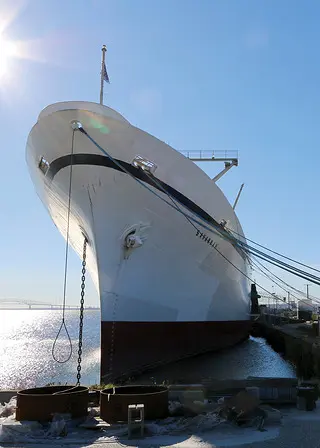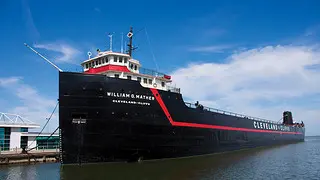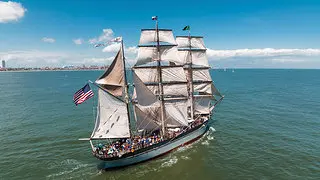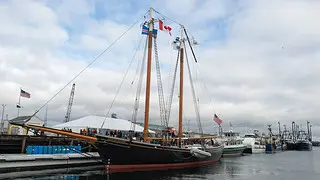
Sea Fare: Historic Ships Around the Country Transport Visitors to a Nautical Past
The British ocean liner RMS Queen Mary, longer and wider than the Titanic, was one of the world’s largest passenger ships at the time of its launch in 1934. It’s so large that when it was retrofitted for World War II service, it carried 8,000 to 15,000 American troops on each trip across the Atlantic. (And yet, painted a camouflaging gray and boasting top-of-the-line speed and maneuverability, the 1,020-foot-long “Gray Ghost” evaded attack by the Axis.) It’s also so large that in 1967, after its wartime and commercial service ended, the ship had to take the long way to its new Pacific port, around the tip of South America, because it is too wide to pass through the Panama Canal.

photo by: The Queen Mary
The Royal Salon on The Queen Mary.
Now permanently docked in Long Beach, California, it continues to astonish as a museum, a hotel, and a dining destination. The restored and renovated Queen Mary reopened in 2023, hosting day-trip visitors, meetings, and events. Its 250 Art Deco staterooms accommodate overnight guests. In 2024, it joined Historic Hotels of America, a program of the National Trust.
Preservation efforts continue, with a recent focus on the meticulous restoration of the ship’s original artwork, including Unicorns in Battle, a gesso panel by Gilbert William Bayes and Alfred J. Oakley that anchors a grand event space. The new, onboard Queen Mary Archive Museum displays original dishware, furniture, and other artifacts.
At NS Savannah in Baltimore, you can also see original furnishings, but with a twist. Here, dishes, chairs, and even light fixtures have a Midcentury Modern motif. NS Savannah, the first nuclear-powered merchant ship, was commissioned as part of President Eisenhower’s Atoms for Peace program. From 1962–65, the ship served as a symbol of the peaceful and safe use of nuclear power, traveling to ports around the world and welcoming both passengers and walk-on visitors. Until 1970, it continued to carry cargo.
The U.S. Department of Transportation’s Maritime Administration (MARAD) has worked to decommission Savannah to enable various potential uses. The ship’s nuclear reactor, inactive since 1970, was removed in 2022. The termination of its nuclear license is anticipated sometime in 2026.
Meanwhile, MARAD has worked to ready the ship for the future, upgrading the HVAC and other systems and restoring public spaces to their midcentury design. The agency is seeking a new home for Savannah, where it will be towed and permanently docked for its next decades of visitation and preservation. For now, the ship is open monthly for tours, as well as on select other dates.
In Cleveland, visitors can tour the 618-foot SS William G. Mather on Lake Erie between May and September. The Mather, which is celebrating its centennial in 2025, was once the state-of-the-art flagship freighter for the Cleveland-Cliffs steel company.

photo by: Barbara Voulgaris/MARAD
NS Savannah is berthed at Baltimore’s Canton Marine Terminal.
It could transport 14,000 long tons of iron ore to steel mills throughout the Great Lakes. Around 1980, its technology was superseded by “self-unloading” ships. (Earlier ships like the Mather needed massive Hulett ore unloaders on shore to empty their holds.) After sitting idle for years—but evading the scrapyard through the work of local historical societies—the Mather has been docked in Cleveland since the 1980s. The neighboring Great Lakes Science Center owns and stewards it as a museum.
Although it was a working cargo ship, the Mather housed about three dozen crew members and hosted company executives and other invitees for weeklong cruises on the Lakes. Today, you can see its restored guest bedrooms and lounges, a wood-paneled dining room, and behind-the-scenes areas like crew bunks, kitchens, the four-story engine room, and the brass- and oak-finished pilot house. Cleveland-Cliffs continuously updated the ship’s technology: The Mather was one of the first Great Lakes ships to have bow thrusters (which help with maneuverability) and radar, and in 1964 it became the first American ship to digitally automate its boiler system. “The Mather is part of a long continuum of innovation, from very small wooden ships on the Great Lakes to the current thousand-foot freighters,” says the Great Lakes Science Center’s Cait Anastis.

photo by: Great Lakes Science Center
The William G. Mather in 2011.

photo by: Ken Blaze
The Mather serves as a floating museum.
In addition to boarding the ship, guests at the Science Center can attend the interactive exhibit Steam and Steel: Propelling the Future of the Great Lakes through September 1, 2025. Afterward, parts of the exhibit will be moved to the ship.
The 19th-century sailing ships ELISSA and SSV Ernestina-Morrissey each offer opportunities not only to visit, but also to sail.
In the late 1970s, Galveston Historical Foundation in Galveston, Texas, towed ELISSA from a scrapyard in Greece as part of its efforts to help renew and preserve the city’s waterfront. After years of restoration by staff and volunteers, the ship was ready to set sail from the Galveston Historic Seaport. Now, for a limited period each April, the historical foundation offers day sails on the 1877 iron-hulled barque. These outings give participants a chance to learn how the ship is sailed and to assist the crew. Most of the year, though, people board the former cargo ship as museumgoers.

photo by: Greenwalt Productions/Galveston Historical Foundation
ELISSA in full sail.
While Galveston wasn’t its original home port, historic records show the ship twice passed through the city in its earlier days. “Our director of the Seaport is fond of referring to it as an F-150 truck,” says Will Wright, the historical foundation’s chief creative officer. “It was built just to haul things.”
Much like a historic building, a historic ship requires constant maintenance. Every two to three years, maritime regulations require ELISSA to be dry-docked so its hull and other components can be examined and repaired as needed. The problems can be unexpected: After Hurricane Ike in 2008, inspectors found electrolytic corrosion to the iron hull, possibly caused by power lines that had fallen into the water. New features, including a ceramic coating on parts of the hull, were added for protection. ELISSA also has modern safety upgrades such as radar and GPS, but the goal is always to keep the ship as close to its historic appearance and operations as possible.
Stay connected with us via email. Sign up today.
The 1894 wooden schooner Ernestina-Morrissey, docked in New Bedford, Massachusetts, has a lively history and is now both a museum and an instructional ship. The ship began as Effie M. Morrissey, a fishing vessel for Gloucester, Massachusetts, fishermen sailing up the Atlantic coast of Canada. It later served as an Arctic exploration vessel and then as a supply and survey ship for the U.S. military during World War II. After the war, it began a new phase as a packet ship, carrying cargo and sometimes passengers between the U.S. and Cape Verde, a former Portuguese colony off the west coast of Africa. In 1964, Ernestina-Morrissey (then called Ernestina, after an owner’s daughter) ended its transatlantic route and stayed in Cape Verde as an inter-island vessel. Nearly 20 years later, after Cape Verde became an independent nation, its government donated the ship to the United States.

photo by: Massachusetts Maritime Academy
Ernestina-Morrissey at home in New Bedford, Massachusetts.
Following multiple restorations (one of which won an award from the National Trust) and inclusion in New Bedford Whaling National Historical Park, the ship joined the Massachusetts Maritime Academy’s fleet in 2022. A National Historic Landmark that undergoes constant maintenance, it houses maritime and leadership training for the academy’s cadets, K–12 STEAM education, and community events from its home port in New Bedford, Massachusetts. From spring to early fall, visitors can sign up for day sails, multi-day learn-to-sail trips, and free deck tours when Ernestina-Morrissey is in port.
It no longer heads to the Arctic or Africa, but Ernestina-Morrissey still travels as far as the Gulf Coast and the Great Lakes. And, like all these historic ships, it takes its visitors back in time.
Donate Today to Help Save the Places Where Our History Happened.
Donate to the National Trust for Historic Preservation today and you'll help preserve places that tell our stories, reflect our culture, and shape our shared American experience.


